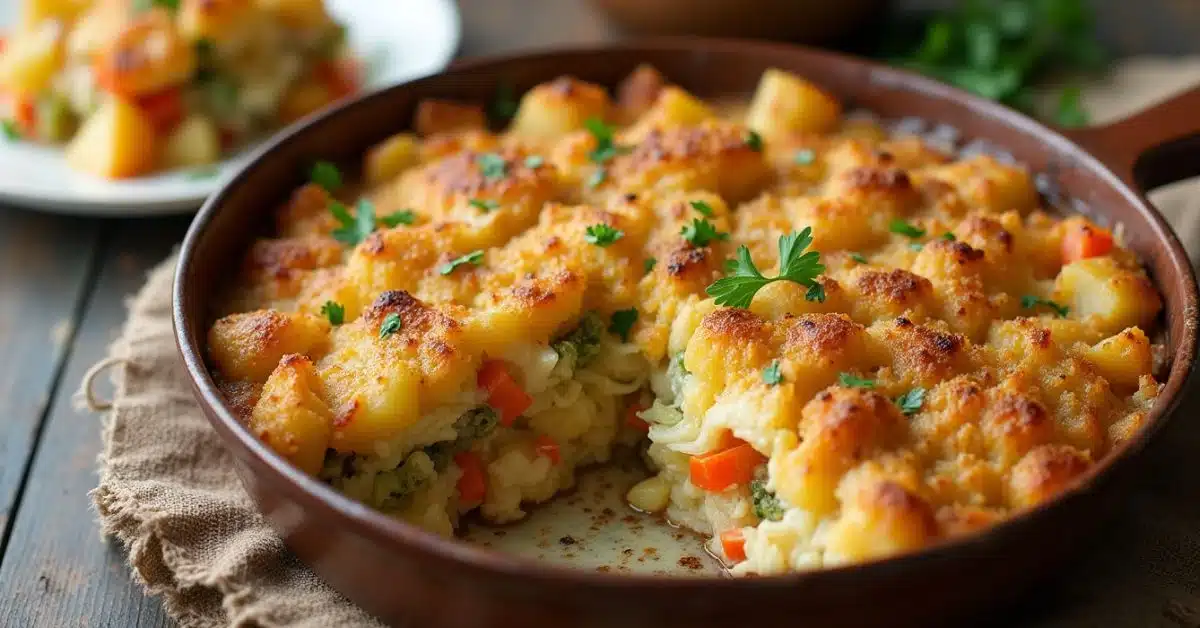Introduction to German Casserole Vegetables
German cuisine stands as a testament to culinary excellence, with its robust flavors, hearty ingredients, and time-honored cooking techniques. At the heart of this gastronomic tradition lies a particularly compelling culinary art form: German casserole vegetables. These dishes are far more than simple side plates – they are a celebration of agricultural bounty, cultural heritage, and the art of transforming humble ingredients into extraordinary meals.
The concept of a vegetable casserole in German cuisine goes beyond mere sustenance. It represents a profound connection to the land, to seasonal rhythms, and to family traditions passed down through generations. Each casserole tells a story – of regional produce, of family recipes carefully guarded and lovingly shared, and of the German people’s deep respect for quality ingredients.
What makes these casseroles truly special is their versatility. They can be a comforting weeknight dinner, a stunning side dish for special occasions, or a complete meal in themselves. From the rolling hills of Bavaria to the northern coastal regions, each area brings its unique touch to vegetable casseroles, creating a rich tapestry of flavors that reflects Germany’s diverse culinary landscape.
Table of Contents
The Cultural Significance of Vegetable Casseroles in German Cuisine
German cuisine is deeply rooted in agricultural traditions, and vegetable casseroles (known as “Auflauf” in German) represent more than just a cooking method – they are a cultural artifact that tells the story of German food history. These dishes emerged from a practical need to make the most of seasonal produce, showcasing the German values of resourcefulness, sustainability, and respect for ingredients.

Historically, vegetable casseroles were born out of necessity. In rural communities, families needed to create filling, nutritious meals using whatever ingredients were available. Farmers would combine vegetables from their gardens, often adding cheese, eggs, or small amounts of meat to create a substantial dish that could feed entire families. This approach to cooking – transforming simple ingredients into something extraordinary – remains a hallmark of German culinary philosophy.
The regional diversity of German casseroles is particularly fascinating. In Bavaria, you might find a hearty casserole with root vegetables and local cheeses. The northern regions, with their proximity to the sea, might incorporate seafood or coastal vegetables. The Black Forest region adds its unique herbs and local produce, creating casseroles that are distinctly their own.
Cultural celebrations and seasonal festivals also play a crucial role in the evolution of these dishes. During harvest festivals, vegetable casseroles become a centerpiece of communal meals, showcasing the year’s best produce. Winter celebrations feature heartier, more robust casseroles that provide warmth and comfort during cold months.
Moreover, these dishes reflect the German approach to eating – food is not just about nutrition, but about community, tradition, and taking time to enjoy a well-prepared meal. Families often spend hours preparing these casseroles, with recipes passed down through generations, each adding their own subtle twist to the original.
Essential Vegetables for Traditional German Casseroles
The magic of German casserole vegetables lies in their carefully selected, high-quality ingredients. Each vegetable is chosen not just for its flavor, but for its ability to contribute to the overall texture, nutrition, and visual appeal of the dish.
Potatoes: The Ultimate Comfort Food
Potatoes are the cornerstone of many German casseroles. They provide:
- Creamy texture
- Substantial nutrition
- Ability to absorb flavors
- Versatility in preparation (sliced, diced, or mashed)
Varieties like Yukon Gold or Deutsche Butterkartoffeln are particularly prized for their rich, buttery flavor and perfect texture in casseroles.
Cauliflower: A Nutritional Powerhouse
Cauliflower brings several unique qualities to German casseroles:
- Mild, nutty flavor
- Excellent nutrient profile
- Ability to absorb seasonings
- Low-carb alternative to potatoes
Traditional German recipes often roast cauliflower before incorporating it into casseroles, intensifying its natural sweetness.
Other Essential Vegetables
- Carrots: Adding natural sweetness and vibrant color
- Kohlrabi: A uniquely German vegetable with a delicate, slightly sweet flavor
- Brussels Sprouts: Packed with nutrients and a slightly bitter taste
- Leeks: Providing a subtle, onion-like flavor and elegant texture
- Cabbage: A hearty vegetable that adds depth and nutrition
Seasonal Considerations
German cooks understand the importance of seasonal vegetables. Each season brings its own special ingredients:
- Spring: Asparagus, young leeks, fresh herbs
- Summer: Zucchini, tomatoes, bell peppers
- Autumn: Root vegetables, pumpkin, late-season greens
- Winter: Hearty root vegetables, preserved vegetables
Nutritional Benefits of German Vegetable Casseroles
German casserole vegetables are nutritional powerhouses that combine taste and health in every bite. These dishes are carefully constructed to provide a balanced, nutrient-rich meal that supports overall well-being.
Comprehensive Nutritional Profile
A typical German vegetable casserole offers:
- High fiber content
- Essential vitamins (A, C, K)
- Important minerals (potassium, magnesium)
- Moderate protein
- Controlled calorie intake
Cooking Methods that Preserve Nutrients
The traditional baking method used in German casseroles helps preserve nutritional value:
- Slow cooking retains more nutrients
- Minimal water used prevents nutrient leaching
- Layering ingredients ensures even cooking
- Use of minimal processing maintains vegetable integrity
Protein and Nutrient Enhancement
Many casseroles include additional nutritional boosters:
- Eggs for added protein
- Cheese for calcium and protein
- Herbs for additional micronutrients
- Occasional meat additions for complete protein
Digestive and Metabolic Benefits
The combination of vegetables and cooking methods provides:
- Improved digestion
- Steady energy release
- Support for gut health
- Anti-inflammatory properties
The nutritional complexity of German casserole vegetables makes them more than just a side dish – they’re a comprehensive approach to eating that prioritizes both flavor and health.
Cooking Techniques for Perfect German Casserole Vegetables
Mastering the art of German casserole vegetables requires understanding a few key cooking techniques:
Vegetable Preparation
- Chop vegetables uniformly
- Blanch harder vegetables to ensure even cooking
- Season each layer carefully
Baking Secrets
- Use a ceramic or glass baking dish
- Cover with foil for initial baking
- Uncover to create a crispy, golden top
Seasoning Tips
- Use fresh herbs like thyme and parsley
- Incorporate traditional German spices
- Balance flavors with high-quality cheeses
Regional Variations of Vegetable Casseroles
Each German region brings its unique twist to vegetable casseroles:
- Bavarian Style: Hearty and meat-heavy
- Northern German Approach: Lighter, more seafood-influenced
- Black Forest Region: Rich with local herbs and cheeses
7 Mouth-Watering German Casserole Vegetable Recipes
1. Classic Potato and Cauliflower Gratin
A creamy, cheesy casserole that combines two beloved vegetables.
2. Kohlrabi and Carrot Bake
A colorful dish showcasing unique German produce.
3. Brussels Sprouts and Bacon Casserole
A savory combination that transforms humble vegetables.
4. Leek and Cheese Auflauf
A vegetarian delight packed with flavor.
5. Mixed Vegetable Harvest Casserole
A celebration of seasonal produce.
6. Cabbage and Potato Comfort Casserole
A traditional recipe passed through generations.
7. Root Vegetable Medley
A hearty dish highlighting Germany’s agricultural bounty.
Selecting the Best Ingredients for Your Casserole
Choosing high-quality, fresh ingredients is crucial for exceptional German casserole vegetables. Visit local farmers’ markets, select organic produce, and prioritize seasonal vegetables for the best results.
Pairing Suggestions for German Casserole Vegetables
Complement your vegetable casserole with:
- Crusty German bread
- Light white wines
- Traditional German sausages
- Fresh green salads
Dietary Adaptations and Alternatives for German Casserole Vegetables
German casserole vegetables are incredibly versatile, making them perfect for various dietary requirements. Let’s explore some innovative adaptations that ensure everyone can enjoy these delightful dishes:
Vegan Transformations
Creating a vegan version of traditional German vegetable casseroles is easier than you might think. Replace dairy cheese with:
- Nutritional yeast for a cheesy flavor
- Cashew-based cheese sauces
- Vegan cheese alternatives made from nuts or soy
- Homemade plant-based bechamel sauce
Gluten-Free Modifications
Ensure your casserole is celiac-friendly by:
- Using gluten-free breadcrumbs for topping
- Replacing wheat-based thickeners with cornstarch or arrowroot
- Checking all ingredient labels carefully
- Using alternative grains like quinoa or rice as a base
Low-Carb and Keto Options
For those following low-carb diets:
- Replace potato-heavy recipes with cauliflower or turnip alternatives
- Use high-fat cheeses and cream
- Incorporate more low-carb vegetables like zucchini and spinach
- Add protein-rich ingredients like bacon or chicken
Allergies and Sensitivities
Adapt recipes for various dietary restrictions:
- Dairy-free alternatives using coconut milk or almond-based products
- Egg-free options with flax eggs or commercial egg replacers
- Nut-free variations for those with allergies

German Casserole Vegetables
Ingredients
- 2 cups mixed vegetables carrots, peas, corn
- 1 onion chopped
- 2 cloves garlic minced
- 1 cup cream of mushroom soup
- 1/2 cup shredded cheese cheddar or Swiss
- 1/2 cup breadcrumbs
- Salt and pepper to taste
Instructions
- Preheat oven to 375°F (190°C).
- In a skillet, sauté onion and garlic until softened.
- Add mixed vegetables and cook for 5-7 minutes.
- Stir in mushroom soup, salt, and pepper.
- Pour mixture into a baking dish.
- Top with cheese and breadcrumbs.
- Bake for 20-25 minutes until golden brown
Common Mistakes to Avoid When Making Vegetable Casseroles
Mastering German casserole vegetables requires attention to detail. Here are comprehensive tips to avoid common pitfalls:
Ingredient and Preparation Mistakes
- Vegetable Selection
- Avoid using overripe or wilted vegetables
- Choose fresh, seasonal produce
- Mix textures and flavors for complexity
- Cutting Techniques
- Use uniform vegetable sizes for even cooking
- Slice vegetables thinly for quicker, more even baking
- Consider the cooking time of different vegetables
- Seasoning Challenges
- Don’t underseason – German casseroles need bold flavors
- Balance salt, herbs, and spices
- Use fresh herbs when possible
- Consider layering seasonings

Cooking and Baking Errors
- Moisture Management
- Avoid watery casseroles by:
- Removing excess moisture from vegetables
- Using a slotted spoon when adding ingredients
- Adding a light dusting of flour or cornstarch
- Avoid watery casseroles by:
- Baking Techniques
- Prevent burning by:
- Using the correct oven temperature
- Covering with foil for part of the cooking time
- Using a lower rack in the oven
- Ensure a crispy top by uncovering in the last 10-15 minutes
- Prevent burning by:
- Equipment Considerations
- Use ceramic or glass baking dishes for even heat distribution
- Avoid overcrowding the baking dish
- Preheat the oven completely before baking
Frequently Asked Questions About German Casserole Vegetables
Q1: Are German casserole vegetables difficult to make? A: Not at all! These dishes are surprisingly simple. With basic cooking skills and fresh ingredients, anyone can create delicious vegetable casseroles. Start with simple recipes and gradually explore more complex variations.
Q2: Can I make these casseroles in advance? A: Absolutely! Most German vegetable casseroles are excellent make-ahead meals. Prepare the entire dish, cover, and refrigerate for up to 2 days. When ready to serve, simply reheat in the oven for 20-25 minutes until heated through and crispy on top.
Q3: Are these dishes healthy? A: Yes, German casserole vegetables are incredibly nutritious. They’re packed with vitamins, minerals, and fiber from fresh vegetables. By controlling ingredients and using healthy cooking methods, you can create nutritionally balanced meals that are both delicious and good for you.
Q4: What’s the best cheese for German vegetable casseroles? A: Traditional German cheeses work best:
- Gouda: Creamy and mild
- Emmental: Nutty and slightly sharp
- Edamer: Smooth and versatile
- Butterkäse: Buttery and soft
Q5: How long do vegetable casseroles typically bake? A: Baking times vary based on ingredients, but most casseroles require:
- 30-45 minutes for standard vegetable casseroles
- 45-60 minutes for heavier, meat-included versions
- Always check for a golden-brown top and bubbling edges
Q6: Can I freeze German vegetable casseroles? A: Most casseroles freeze exceptionally well. Follow these tips:
- Cool completely before freezing
- Use freezer-safe containers
- Freeze for up to 3 months
- Thaw in the refrigerator overnight
- Reheat in the oven to maintain texture
Conclusion: Embrace the Comfort of German Casserole Vegetables
German casserole vegetables represent more than just a meal – they’re a culinary journey through tradition, nutrition, and flavor. Whether you’re a cooking enthusiast or a curious food lover, these dishes offer something truly special.
